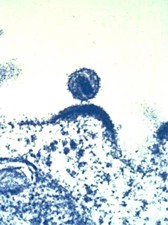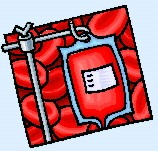Section 2: HIV/AIDS

Test your knowledge of all the HIV/AIDS pages with the HIV/AIDS Quiz
Biology
C:
Contents:
AIDS is the untreated form of a disease caused by the human immuno-deficiency virus (HIV). This virus is carried by the blood within the body.
It is a retrovirus which destroys CD4 cells that protect humans from a range of pathogens - i.e. infections that can be viral, bacterial or fungal.
When the CD4 cell count falls as a result of being HIV+, the body loses immunity and is therefore more prone to infections brought by other diseases. These are mainly associated with tuberculosis, pneumonia, sexually transmitted infections (STIs), malaria and some skin cancers.
The image on the left shows the virus that causes AIDS budding out of a human immune cell, which the virus infects and uses to replicate. Click on the image to see a bigger version.

The retrovirus can enter the body from an infected person to a susceptible person in five different ways:
1. Heterosexual sex. As a result of the exchange of bodily fluids during unprotected sexual intercourse (without a condom).
The virus can move from male to female and female to male; men and women can both be carriers and both be susceptible to receive the infection.
The chance of infection is much higher when a person has other STIs, especially when there are open sores and infections in the genital areas.
2. Homosexual anal sex (males with males) if unprotected (without a condom). Again there is a higher risk of infection where there are open sores.
3. Intra-venous injections using unclean shared needles or other instruments. Drug-users in Western societies have been among the most vulnerable groups.
HIV/AIDS is growing rapidly in Eastern Europe and the former Soviet Union. The spread of the disease in these countries is thought to be associated with the serious and growing problems of intravenous drug use and infected needles.
In order to try and stop the spread of HIV/AIDS in this way, many needle exchanges have been set up to allow drug users to get clean needles.
In Africa one route of infection is thought to be traditional scarifying, circumcision (of boys and girls) and body marking with infected razor blades or other instruments.
In order to try and reduce this problem, traditional healers and religious leaders, who often carry out these procedures, are targeted in public health interventions to make them aware of the risks.
4. Blood transfusions with infected blood products. This is why blood which is donated in Western societies is screened (tested) for HIV.
This testing isn't carried out as much in some parts of the world, and it is thought that one of the major outbreaks of HIV in China in 2003 has been as a result of use of infected blood products.
5. Mother-to-child transmission. Mothers can pass HIV/AIDS onto their babies both before they are born (in the womb) and after they are born during breast feeding as the mother's milk may be infected.




Because of the ways that HIV/AIDS spreads, some people are more at risk of infection than others.
The most vulnerable groups are people who are sexually active, i.e. men and women aged between about 15 and 50 and married in most societies.
However, unmarried adolescents beginning to be sexually active are at high risk. Having unprotected sex, and with multiple partners, also increases the risk of infection.
Because of the spread of AIDS through needle sharing, intravenous drug users are at high risk.
Mother-to-child transmission affect infants. Not many infants born HIV+ will survive to their fifth birthday.
The graph on the left shows the age and sex distribution of those who are affected in South Africa. Click on the image to see a larger version and explanation.

HIV can remain dormant in the body for several years with no symptoms noticeable. This dormant period can even last over a decade.
The average is about eight years in developed countries, and less in Africa.
Even during this time, when there are no symptoms, HIV can be can be detected by a blood test.
When the virus begins to be active, the first signs are often weight loss and loss of energy. People are also more susceptible to infections, for example diarrhoea and other intestinal infections.
HIV kills CD4 cells until full-blown AIDS is reached. A person is defined as having AIDS when their CD4 cell count falls below a certain level.
Because HIV affects the body by reducing immunity to infection, people who are HIV+ are more susceptible to other diseases and epidemics.
Recently there has been a worldwide increase in the number of people suffering from tuberculosis and this is partly because of the rising prevalence of people with HIV/AIDS who are vulnerable to tuberculosis.
The image on the left is the logo of the joint commission on HIV and TB which is part of the WHO. The problems are so closely related that the WHO recognises the need to deal with TB and HIV in joined up strategies. The slogan is 'Two diseases, one patient'.
There is a strong association between HIV/AIDS and other STIs.

Source: WHO.org
One consequence of this relationship between HIV/AIDS and other diseases and infections is that people do not necessarily die of AIDS directly.
Instead, people who are HIV+ may die from one or more of the infectious diseases to which they have become vulnerable.
One of the main reasons why Africa has such a high death rate related to HIV-AIDS is because there is a high rate of infection of other diseases.
Infection is high of both environmental and socio-economic factors:
Environmental factors: Bacteria which cause many other infections thrive in the hot and humid climate in many areas of Africa. There is a general relationship between amount of infection and climate conditions.
Socio-economic factors: Poverty is serious and widespread in Africa. Poor people have poor nutrition, live in poorly built and poorly ventilated housing, often don't have access to clean water and so are more vulnerable to infections. In addition to this, medical services cannot meet the health needs of the people.
The photo on the left shows an eating place in Nairobi, Kenya. Click on the image to see a bigger version.
In this way, poverty makes the environmental problems much worse. The environmental problems mean that water is often contaminated and poverty means that people don't have access to clean water.
Trying to lower the rates of poverty through poverty alleviation programmes is one way that the general level of infection may be lowered.
Poverty alleviation programmes also allow governments to provide better health care, especially more drugs to reduce the general level of infection. Even if drugs to treat HIV/AIDS aren't provided, by treating the other infections, the number of people who die can be minimised.

Now test what you've learnt from this page.
2. Which three of these are ways in which HIV/AIDS can be spread?
Click the three you think they are and then click submit to find out if you are correct. Unless you get all three right it will tell you you're wrong. Click reset to try again.
3. Which TWO of these are ways in which children born to HIV+ mothers may inherit the disease?
Click the two you think they are and then click submit to find out if you are correct. Unless you get both right it will tell you you're wrong. Click reset to try again.
6. Which THREE of the following are particularly high risk groups for HIV/AIDS?
Click the three you think they are and then click submit to find out if you are correct. Unless you get all three right it will tell you you're wrong. Click reset to try again.










